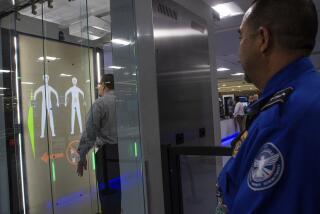All Systems Go: Airports offer help in preparing to fly with family members who have developmental disabilities
Oakland mom Yesenia Rosas can make a family road trip with relative ease, but she’s less confident about boarding a flight with her two young children, unsure how they will handle the myriad sensory experiences of air travel.
“They get overwhelmed, and it’s very frustrating because they don’t have the words to say, ‘Mom, this is too much for me,’’’ Rosas said of Yatziri, 7, and Yaxkin, 9, who are on the autism spectrum. “They express it with behavior.”
To spare her children the stress and herself the potential judgment of other passengers, Rosas has avoided flying. But she’s warming to the idea after participating in Ready, Set, Fly!, a program at San Francisco International Airport that lets people with intellectual and developmental disabilities and their families practice navigating the airport before they book a trip.
“You really want to be able to assess your family members’ tolerances and triggers,’’ said Meredith Manning, communications director for the Arc San Francisco, a community-based agency that partners with the airport to host the annual event. “You can’t simulate this at home on your couch.”
The Arc supports individuals with autism, Down syndrome and other disabilities to help them achieve personal goals and lifelong success, so helping clients decide whether air travel is possible is mission aligned. This deeper level of customer service makes sense for the travel industry too; in this controlled setting, people can identify challenges in advance and take the time to resolve them.
Missing those airport announcements? Here’s how to overcome that sound barrier »
SFO partners with the Arc, the Transportation Security Administration and JetBlue to provide a typical day of travel, beginning curbside and ending with boarding a grounded plane, which JetBlue provides.
At every stage — ticketing, security screening, boarding — individuals and families are supported by a behavioral specialist and a cadre of volunteers whose goal is to help them answer a crucial question: Can they do this?
“We discovered a lot of families weren’t flying because they didn’t know if they could or if their children could handle that,” said Nina Asay, chief of strategic planning and innovation at the Arc.
Each part of the simulation gets them closer to finding out. At security, TSA volunteers who have been trained by Arc help participants get through that process.
“Operationally, this gives us a chance to make sure people don’t have a problem,” said Bertram Jones, TSA’s deputy assistant federal director. “If something happens at a checkpoint, it affects a lot of other people in line.” He stays with the group throughout the demonstration to answer questions.
At the gate, as in real life, there is some waiting around before boarding. The flight crew takes it from there.
“Getting on the aircraft is the single biggest challenge for many of these young folks,’’ said Ken Johnson, JetBlue’s general manager for San Francisco. “The parents get to find out what will work best in helping them cope with the boarding process so when they do make a trip it will be successful.”
All systems go: Our monthly column about managing travel with a disability »
The concept behind Ready. Set, Fly! did not originate at SFO. Many airports understand the value of supporting travelers with disabilities well before a trip is booked.
Wings for All, implemented by the national Arc, runs at various airports across the country.
LAX has hosted three such practice sessions. Individuals with autism or their parents can contact the airport’s ADA office directly to arrange a one-on-one guided “dry run” through the airport experience.
And John Wayne Airport in Orange County will soon launch its program for people with disabilities called JWA Helping Hands.
“We can take people up through the check-in process, get them through security with minimal amount of stress and get them to board the airplane,’’ said Deanne Thompson, the airport’s manager for public affairs.
The commonality is a focus on education for the individual with a disability, their families, airport officials and front-line airline personnel.
In this learning lab, everyone is a student.
Brian Poole, SFO’s guest services manager, said he can now quickly recognize when an individual is “stimming,” a coping behavior such as rocking, vocalizing or hitting that helps a person with an intellectual disability stabilize their emotions.
“I found that really helpful coming from not having been exposed to that before,’’ Poole said, adding he learned from Arc San Francisco that he need not intervene.
Ready, Set, Fly’s team took inspiration from Navigating MSP Airport: Practice Makes Perfect, a program at Minneapolis-St. Paul International Airport that serves about 500 individuals a year.
It’s offered monthly and to anyone with a disability, anxiety about flying or other serious concern.
“We changed the name from Navigating Autism to Navigating MSP so that anyone who would benefit from a practice run can do it,’’ said Shelly Lopez, administrative and emergency programs coordinator at the Metropolitan Airports Commission, which operates MSP.
Rosas said her kids would likely do another dry run before she attempts a dream vacation to Walt Disney World in Florida.
When her son points to the sky and says, “Mama, airplane,’’ she knows “he’s trying to tell me he wants to go on a plane,’’ she said.
“It’s those times that you realize, with the right planning and opportunities, your child can engage and be part of the community and that’s just priceless.’’
More to Read
Sign up for The Wild
We’ll help you find the best places to hike, bike and run, as well as the perfect silent spots for meditation and yoga.
You may occasionally receive promotional content from the Los Angeles Times.






